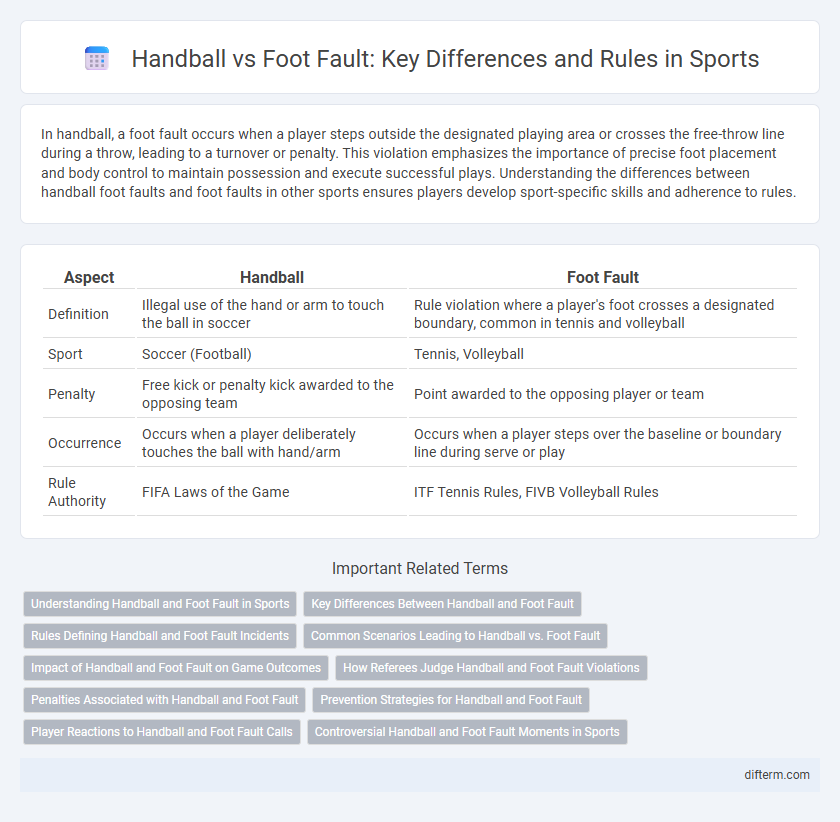In handball, a foot fault occurs when a player steps outside the designated playing area or crosses the free-throw line during a throw, leading to a turnover or penalty. This violation emphasizes the importance of precise foot placement and body control to maintain possession and execute successful plays. Understanding the differences between handball foot faults and foot faults in other sports ensures players develop sport-specific skills and adherence to rules.
Table of Comparison
| Aspect | Handball | Foot Fault |
|---|---|---|
| Definition | Illegal use of the hand or arm to touch the ball in soccer | Rule violation where a player's foot crosses a designated boundary, common in tennis and volleyball |
| Sport | Soccer (Football) | Tennis, Volleyball |
| Penalty | Free kick or penalty kick awarded to the opposing team | Point awarded to the opposing player or team |
| Occurrence | Occurs when a player deliberately touches the ball with hand/arm | Occurs when a player steps over the baseline or boundary line during serve or play |
| Rule Authority | FIFA Laws of the Game | ITF Tennis Rules, FIVB Volleyball Rules |
Understanding Handball and Foot Fault in Sports
Handball and foot fault are critical violations in sports, with handball referring to the illegal use of the hand or arm to control the ball, commonly penalized in soccer and handball games. Foot fault occurs when a player's foot crosses a designated boundary line during serving or play, frequently observed in tennis and volleyball, resulting in loss of point or serve. Understanding these rules enhances fair play and ensures proper enforcement of game regulations across various sports disciplines.
Key Differences Between Handball and Foot Fault
Handball involves a player deliberately touching the ball with their hand or arm, which is illegal in soccer, while a foot fault typically refers to a player stepping over the ball during a serve in tennis or violating the line in sports like volleyball, leading to a penalty. In handball violations, the focus is on using the hand or arm improperly, whereas foot faults concern foot placement and movement rules during play. The key distinction lies in the body part involved and the specific rule breach unique to each sport's regulations.
Rules Defining Handball and Foot Fault Incidents
Handball in sports is defined by the intentional or accidental contact of the ball with the hand or arm, violating the rules that specify permissible touches during play. Foot faults occur when a player improperly uses their foot in a manner that breaches the regulations, such as stepping over a boundary line or into a restricted area during a serve or play. Clear rule distinctions help referees determine handball infractions versus foot faults, ensuring fair gameplay in handball, soccer, and similar team sports.
Common Scenarios Leading to Handball vs. Foot Fault
Common scenarios leading to handball in sports often involve players unintentionally touching the ball with their hands during defensive plays or aerial challenges. Foot faults typically occur when a player steps outside designated boundaries or over the line during serves or throw-ins. Both violations disrupt gameplay flow, resulting in turnovers or free throws for the opposing team.
Impact of Handball and Foot Fault on Game Outcomes
Handball and foot fault violations significantly influence game outcomes by disrupting team momentum and altering possession dynamics in handball matches. Handball infractions often result in free throws or penalties, providing scoring opportunities for the opposing team, while foot faults typically lead to turnovers that can shift tactical advantages. These rule breaches not only affect scoring potential but also impact player discipline and strategic adjustments throughout the game.
How Referees Judge Handball and Foot Fault Violations
Referees judge handball violations by assessing whether a player deliberately contacts the ball with their hand or arm in a way that gains an unfair advantage, considering factors such as the hand's position and movement towards the ball. Foot fault violations are identified by observing if a player's foot crosses the boundary lines during a serve or stepping on the crease in handball penalty shots, which disrupts the fairness of play. Consistent application of these rules relies on referees' training in interpreting specific signs like intentionality and line infractions to maintain game integrity.
Penalties Associated with Handball and Foot Fault
In handball, penalties for handball offenses include free throws, penalty throws, and possible suspensions depending on the severity and intent behind the infraction. Foot faults in handball, such as stepping inside the goal area during a shot, result in turnovers and free throws for the opposing team. Both handball handball penalties and foot fault consequences are strictly enforced to maintain fair play and game flow.
Prevention Strategies for Handball and Foot Fault
Effective prevention strategies for handball and foot fault violations involve focused training on proper technique and spatial awareness. Regular video analysis combined with refined foot positioning drills helps athletes maintain compliance with game rules, reducing the risk of fouls. Coaches emphasize muscle memory development and dynamic movement control to anticipate and avoid infractions during fast-paced play.
Player Reactions to Handball and Foot Fault Calls
Players often display intense reactions to handball and foot fault calls, reflecting the high stakes of maintaining fair play in handball matches. Handball infractions typically provoke disputes due to the fast-paced, close-contact nature of the sport, leading to appeals and sometimes heated exchanges with referees. Foot fault calls, although less frequent, trigger visible frustration as they disrupt offensive rhythm, compelling players to adapt their foot positioning and timing immediately.
Controversial Handball and Foot Fault Moments in Sports
Controversial handball incidents often ignite heated debates, especially when video technology fails to provide clear evidence, impacting crucial match outcomes in football and handball alike. Foot faults in sports like tennis and handball challenge referees' judgment, with borderline calls influencing player momentum and results. These contentious moments highlight the ongoing struggle between human error and the demand for precise rule enforcement in high-stakes competitions.
handball vs foot fault Infographic

 difterm.com
difterm.com